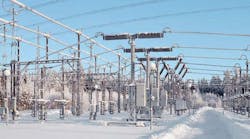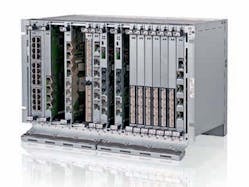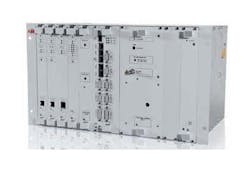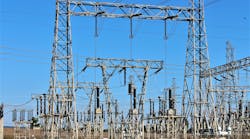The geographical scale of transmission and distribution networks presents a unique challenge to maintaining reliable communications. The size of most networks is a challenge in itself, but the topologi- cal layout can make the provision of redundant rings or looped connections difficult to implement, and with such critical infrastructure fail-safe connectivity is essential ➔ 1.
1 Communication requirements evolve with smart grids
The term "critical communications" immediately conjures images of engineers battling at control room desks to reroute power in the face of overwhelming disaster. In fact most communication is more sedate, though nonetheless critical. The messages that really matter, and upon which the safety of the network depends, are generally sent, received, and acted on in less than a blink of an eye. Such communications are dependent on Quality of Service (eg, latency) rather than bandwidth. The missioncritical messages themselves are tiny, but must be delivered within a predictable timeframe. These days, many networks on higher voltage levels are already laced with fiber connections that are mapped into redundant loops, and ABB's FOX multiplexers can ensure those messages are delivered on time with its Powerline Communication (PLC) backup links for important high-voltage lines ➔ 2.
2 ABB's FOX multiplexers ensure messages are delivered on time
But in the more remote regions of the world, pure Powerline networking is heavily used. In many places, rather than run fiber out to a spur from the loop, it makes better economic bandsense if PLC – or in special cases microwave – is the technology used. To ensure that such remote stations are not cut off from the smart grid, ABB's range of Electrical Transmission Line (ETL) PLC equipment will carry up to 320 kb/s, while microwave solutions need line-of-sight to provide higher capacities up to 622 Mbit/s ➔ 3.
3 ABB's ETL Powerline routers can carry up to 320 kb/s while ensuring that remote stations are not cut off from the smart grid.
But if such capacities aren't needed for emergency messages, what is taking up all that cabling capacity? Equally important to the long-term viability of the utility network are the routine messages that report the operational status of transformers, the temperature of circuit breakers, the viscosity of cooling oil, as well as many other environmental factors affecting the grid. This data needs to be aggregated and analyzed by software that can spot developing trends and highlight conjunctive events, showing the impact of new machinery or excessive loading. This analysis lets central operations spot developing problems, schedule remedial work before anything breaks and generally keep watch over the state of the network.
A smart substation can generate tens of megabytes of data every second and dealing with this requires careful thought. Of course, the wide-area network does not have to carry all that data; data, gathered by high-capacity Ethernet (managed with ABB’s AFS switches to ensure IEC 68150 compliance) over intra-substation fiber, is fed into the substation’s intelligent electronic devices (IEDs) and remote terminal units (RTUs), which take out repetitive and redundant information. But when half a dozen substations are linked, the network load and potential for failures start to build.
Maintenance and administrative traffic is also an essential part of the smart grid but it can also place a considerable load on the communications infrastructure. If communication is used only during an emergency, or to give instructions to field staff via the engineering order wire (EOW), then the bandwidth required is quite minimal. The provision of intranet into substations and the interconnection of office local area networks (LANs) via operational networks drive the bandwidth requirement easily to several tens of megabits per second.
Communication – the smart grid enabler
A failing communications network can have serious implications beyond the obvious reduction in network visibility. The autonomous capability of the smart grid is dependent on the ability of the sensing components to exchange information, such as in the case of distance protection for direct breaker tripping, where a breaker needs to know what was sensed remotely before deciding where the line should be cut to isolate a fault. It may be more complicated when the supervisory control and data acquisition (SCADA) system, for example, has to decide how to respond to a suddenly- silent or misreporting IED. Therefore, protecting the communication network becomes just as important as protecting the services being delivered.
When networks experience massive breakdowns, the communications network cannot afford to be part of that failure. With limited resources, and public safety often at risk, the network needs to be able to tell a utility where to send staff and what parts of the network are still operational, thereby keeping outages to a minimum and reducing costs while increasing safety.
The Electric Power Research Institute (EPRI) has been looking in detail at the cost of a smart grid.1 According to EPRI, a major part of a smart grid investment will be in the communications infrastructure, which could also lead to substantial cost savings. To illustrate this point, the Philadelphia utility, PECO, avoided 7,500 engineer visits in 2005 alone thanks to smart grid communications, which verified if a customer-reported outage was genuine.
Footnote
1 http://www.epri.com/abstracts/Pages/ ProductAbstract.aspx?Product Id=000000000001022519
The smart grid challenge
As part of the smart grid concept, communication should no longer be limited to operations within a single company. To gain a view of the entire grid, a transmission system must talk to a distribution system, generators must be able to read demand from customer premises, and communication networks need to be seamlessly integrated so decisions can be based on the whole grid rather than parts of it. This integration runs counter to how the industry has evolved to date. Fragmentation has been created to drive competition, but for the smart grid, this fragmentation presents a greater challenge. Diverse communication equipment and strategies need to be integrated to achieve the goal of an intelligent grid.
National utilities and governments demand compatibility in preparation for integrated communications. Standards such as IEC 61850 ensure compatibility within the utility, and ABB has been intimately involved in drafting those standards for decades. Communication between utilities is equally important and therefore ABB has been equally supportive in creating the Inter-Control Center Communications Protocol (ICCP, also known as IEC 60870-6) to provide communication between utilities, both upstream and downstream. ABB has already deployed gateway software ensuring that its customers can integrate their systems to the benefit of the smart grid itself.
Smart grid communication technologies
ABB has decades of experience building communication networks, from the early deployments using ripple signals to control water boilers and streetlights, to the development of PLC, laser-driven fiber optics, and the mesh-radio techniques blanketing the smart city of the future.
While ripple is no longer in use, PLC technology is still being used, with the ETL600 providing communications that can keep running in the most-challenging environments, such as transmitting over more than 1,000 km without the use of repeaters. These days, PLC is often deployed as a backup system, running in parallel with fiber-optic lines, especially where the geography makes a redundant ring of fiber impractical.
4 ABB's FOX (in cabinets) support multipurpose networks with utility-specific solutions.
If fiber is available in a network, optical networks are deployed. While circuitbased SDH systems are mainly used in a transmission system [1], low-voltage distribution systems typically require less Quality of Service and may run based on packet-switched Ethernet networks. Considering the harsh utility environment and specific utility applications, these solutions require special product design (eg, fanless, extended operational temperature). ABB's FOX and AFS family provide the required utility features for SDH as well as for Ethernet ➔ 4.
Often, there is no communication media available, which in turn leads to the use of wireless solutions. An overview of the main principals can be found in ABB Review 1/2013 [2]. The challenges imposed by the smart grid can be best met by standardized 802.11 WiFi technology, which provides sufficient bandwidth to combine different applications and co-run different operators in one network. ABB’s Tropos 802.11 product line enables highly reliable industrial-grade mesh 802.11 systems that simultaneously support various applications over one unified network. Even IEC 61850 generic object oriented substation events (GOOSE) messaging can be realized for low-voltage applications via this solution. More details on the specific protocol securing high network availability can be found in ABB Review 4/2013 [3].
Governments and the general public see clear advantages in an intelligent grid, but some utilities have been slow to embrace its advantages, in particular when considering decreasing energy prices and the fact that they may end up working closely with companies they’ve considered competitors, suppliers or customers. These problems can be addressed with international standards, such as IEC 68150, with multiservice platforms like ABB's FOX or Tropos platforms, which will support multipurpose networks with utility-specific solutions like ETL PLC, as well as AFS Ethernet switches. These solutions can smooth the way, but it can be difficult for utilities to build a business case. Ultimately, political will and long-term investment is required to give utility grids the intelligence they need.
Mathias Kranich
ABB Power Systems
Baden, Switzerland
[email protected]
---------------------
References
[1] M. Kranich, et al., "Making the switch: ABB's new multiservice multiplexer, FOX615, meets the new challenges faced by operational communication networks," ABB Review 1/2013, pp. 36–41.
[2] P. Bill, et al., "Fine mesh: Mesh 802.11 wireless network connectivity," ABB Review 1/2013, pp. 42–44.
[3] P. Bill, et al., “Robust radio: Meshed Wi-Fi wireless communication for industry,” ABB Review 4/2013, pp. 74–78.






